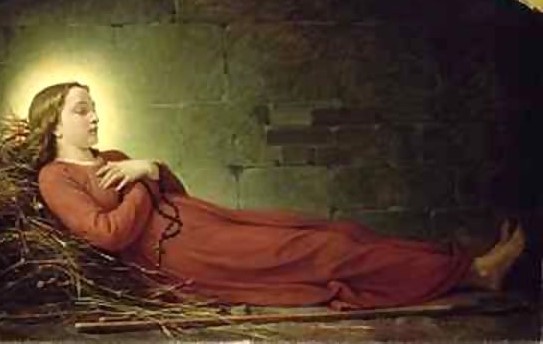
St. Germaine Cousin was a simple poor shepherd girl who bore nothing but love and faith in her heart despite suffering horrendous abuse. There is some doubt about Germaine’s parentage, but it is likely that she was the daughter of Laurent Cousin and his unnamed wife, who died when Germaine was a baby. Laurent was the mayor’s son in the village of Pibrac, near Toulouse, France. He had inherited a prosperous farm, but was weak-willed and a poor businessman, and, by the time Germaine was born in 1579, the family was poor. Germaine was born with a paralyzed and malformed right hand .
THE WICKED STEPMOTHER
Laurent then married a woman traditionally known as Hortense, who had no use at all for Germaine, then a toddler. To make matters worse, Germaine was showing signs of an ailment called scrofula, now known as tuberculosis of the lymph nodes. The illness manifested itself with abscesses on her neck and left her immune system greatly diminished. Hortense’s neglect of the child increased with time and little Germaine was known to eat from the dog’s dish due to hunger. Hortense also poured scalding hot water on her legs, which Laurent pretended not to notice.
BANISHED TO THE BARN
By age five, Germaine was banished to the barn and was sent to work every day as a shepherdess. She had not even a blanket in the winter cold of the barn, and would use the warm bodies of the sheep to keep warm. She was also required to spin wool each day, and was beaten if she did not meet her quota. The only food given to her was the previous day’s scraps in the morning. She never had a pair of shoes, and had only tattered garments for clothing. She was never sent to school like her step-siblings, and was only given a brief introduction to the Faith when she listened to a children’s lesson after Sunday Mass.

PUTTING THE NEW-FOUND FAITH TO USE
From that little bit of education, Germaine developed an active prayer life and a great love for the Mass, for the rosary, and for the noon recitation of the Angelus prayer. One day, when she greatly desired to go to a weekday Mass, Germaine stuck her wooden spindle into the ground, asked her sheep to stay put, and made the Sign of the Cross. When she returned from Mass, the sheep had inexplicably remained where she left them. She continued the practice of leaving her sheep in the care of Divine Providence in order to attend Mass each day, and no harm ever came to them. This prompted curiosity from the villagers, since the adjacent forest was well known to be populated by wolves.
Despite the unbridled cruelty of Germaine’s step-mother, young Germaine requited her with only love and loyalty. She would dutifully appear at the back door each morning to receive her scraps of food – the household’s leftovers of the previous day and her only provisions – and her daily work orders.
EXTRAORDINARY FORGIVENESS
One story demonstrates Germaine’s extraordinary capacity for forgiveness. Beggars would come to her for her kindness and a few bites of food. On one cold winter day, Germaine was carrying in her apron some bread scraps to share with a beggar and was caught by Hortense, who chased her to the town square with a stick. Thinking that she would expose Germaine as a thief, Hortense demanded that she open her apron. When she did, unseasonal flowers in bloom fell to the frozen ground. Germaine offered her step-mother a flower, saying, “Please accept this flower, Mother. God sends it to you as a sign of His forgiveness.” News of the kindness and piety of the shepherd girl spread, and children would go to her in the fields. When they expressed concern for her lack of food and her many bruises from the beatings, she told them how the bruises made her resemble Christ in His wounded state. Germaine had a strong devotion to the rosary, and the only one she ever owned, she made herself from a piece of string. Although her father and step-mother at last allowed her to come to the family home, Germaine declined, since she was content to live in the barn.
A HOLY DEATH
On an unknown date in the late spring of 1601, Germaine did not appear as usual at the back door, and her father found her dead in the barn, with the string rosary in her hands. Three different traveling witnesses, in two different locations, saw and heard an angelic escort, accompanied by bright light during the previous night as “a maiden” was lifted to heaven. When these travelers arrived, the townspeople took them to the Cousin farm, arriving just after Germaine’s body was discovered. At the time of her death, she was twenty-two years old.

St. Germaine Cousin never left her village and never visibly accomplished great things. However, by her devotion to God and her compassion toward the needy, although needy herself, she exemplified the Beatitudes and doubtlessly helped atone for many sinners. Her unfailing kindness to a violently “wicked stepmother” eventually softened the poor woman’s heart. Germaine’s cause for canonization took a very crooked road. Her body was interred under the floor of the village church, unmarked, where, after forty years, it was discovered to be incorrupt, prompting prayers for her intercession. Miracles abounded, and one grateful recipient bought a fine casket for the body. In 1700, an extensive file with facts and testimonies was sent to Rome for her cause, but was lost due to a series of mishaps. During the French Revolution, an eruption of widespread sacrilege and apostasy in France, her lead casket was confiscated to make weapons, and her body was thrown in an open pit with quick-lime, which should have destroyed it. After the Revolution, her body was found to still be mostly intact. In 1765, the village priest wrote a book in order to preserve her story. Since miracles due to her intercession continued to occur, her cause was reintroduced in 1850 when thirty bishops requested it. She was canonized in 1867, and given June 15 as her feast day. She is a patroness for orphans, disabled people, and victims of abuse. There is a shrine in her town of Pibrac which includes a beautiful reliquary bearing her remains.
